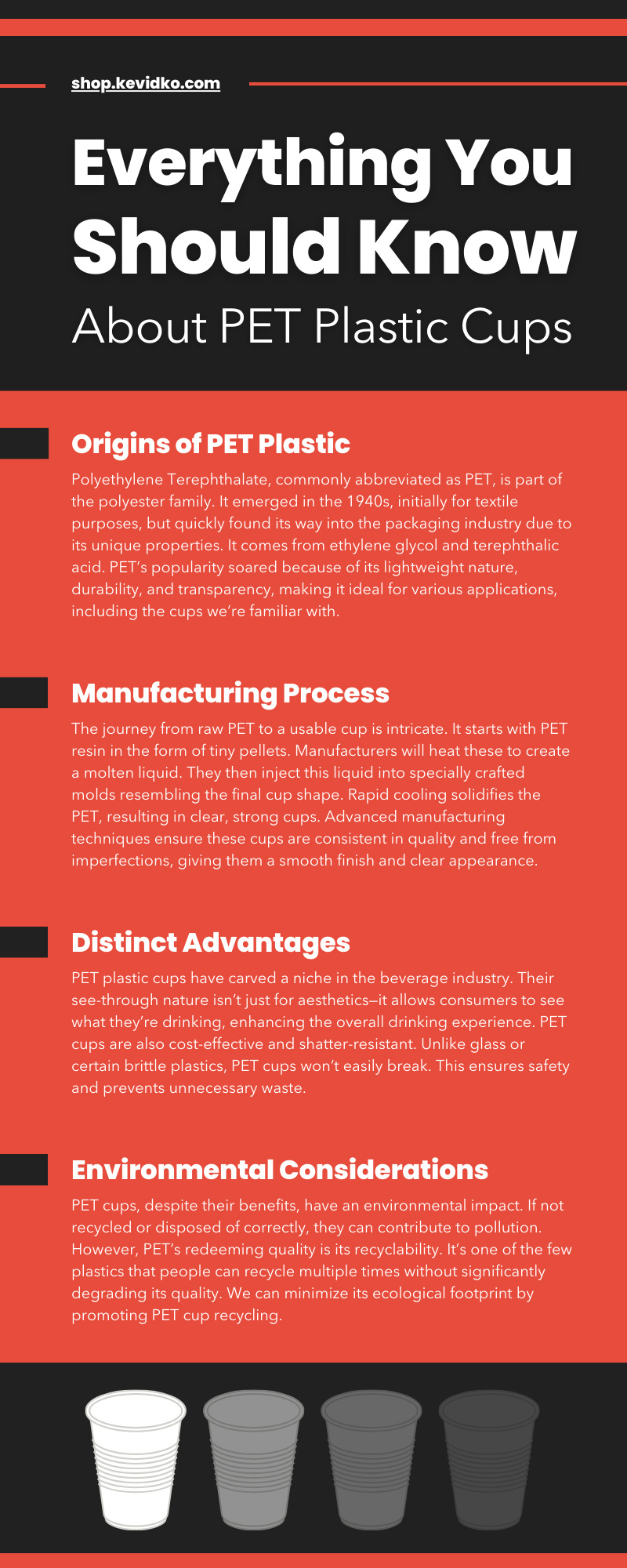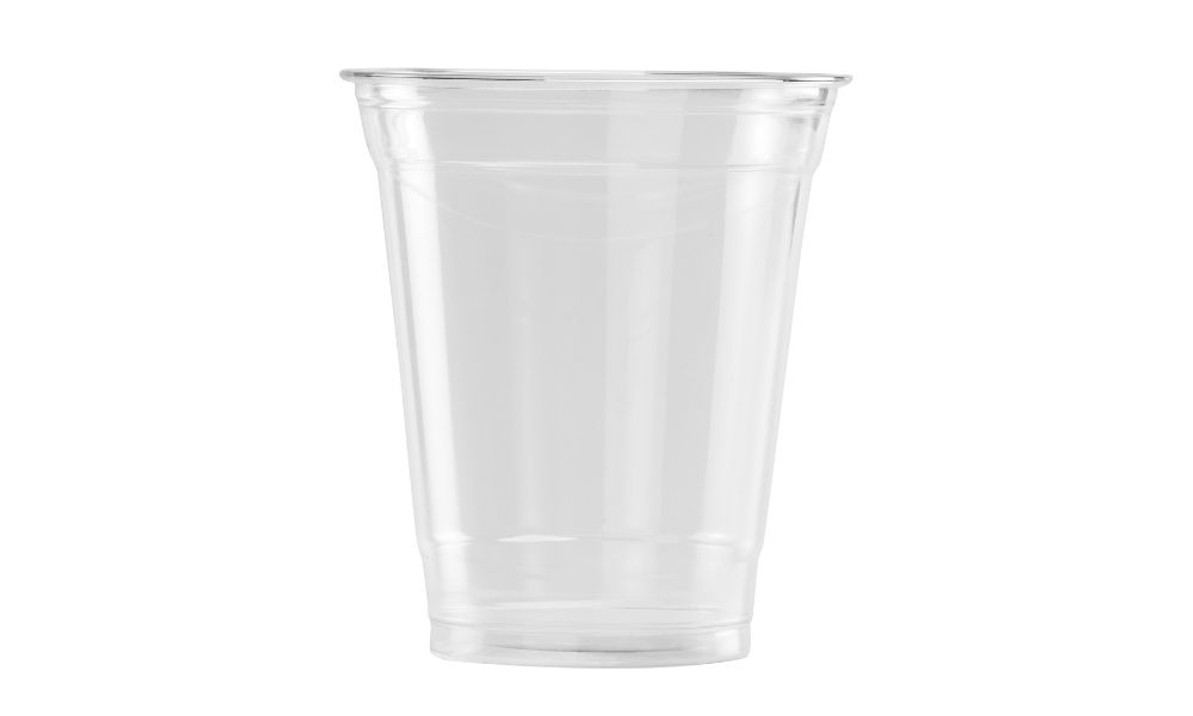Everything You Should Know About PET Plastic Cups
PET plastic cups are more than just the clear cups you use once and dispose of. These cups, widely popular for their clarity and durability, are popular globally for holding and serving beverages. But what’s the story behind these cups? How are they produced, and what makes them eco-friendly? Let’s explore everything you should know about PET plastic cups.
Origins of PET Plastic
Polyethylene Terephthalate, commonly abbreviated as PET, is part of the polyester family. It emerged in the 1940s, initially for textile purposes, but quickly found its way into the packaging industry due to its unique properties. It comes from ethylene glycol and terephthalic acid. PET’s popularity soared because of its lightweight nature, durability, and transparency, making it ideal for various applications, including the cups we’re familiar with.
Manufacturing Process
The journey from raw PET to a usable cup is intricate. It starts with PET resin in the form of tiny pellets. Manufacturers will heat these to create a molten liquid. They then inject this liquid into specially crafted molds resembling the final cup shape. Rapid cooling solidifies the PET, resulting in clear, strong cups. Advanced manufacturing techniques ensure these cups are consistent in quality and free from imperfections, giving them a smooth finish and clear appearance.
Distinct Advantages
PET plastic cups have carved a niche in the beverage industry. Their see-through nature isn’t just for aesthetics—it allows consumers to see what they’re drinking, enhancing the overall drinking experience. PET cups are also cost-effective and shatter-resistant. Unlike glass or certain brittle plastics, PET cups won’t easily break. This ensures safety and prevents unnecessary waste.
Environmental Considerations
PET cups, despite their benefits, have an environmental impact. If not recycled or disposed of correctly, they can contribute to pollution. However, PET’s redeeming quality is its recyclability. It’s one of the few plastics that people can recycle multiple times without significantly degrading its quality. We can minimize its ecological footprint by promoting PET cup recycling.
Recycling Process
Recycling is pivotal in the PET lifecycle. Once collected, PET cups go to recycling centers. Here, they’ll go through the washing and cleaning process to remove any contaminants. A grinder will then crush the cleaned cups into flakes. These flakes then go through the melting and reforming process, and they ultimately come out as new cups. By embracing recycling, we can reduce the demand for virgin PET production.
Alternative Uses
Recycled PET doesn’t just reincarnate as another cup. Its potential is vast. We can transform recycled PET into fibers that find their way into apparel, home textiles, and carpets. These cups can also regain another life as containers for various products or even strapping materials. Every recycled PET item can have multiple lives, showcasing the importance of recycling in sustainable living.
Health and Safety
Amid growing concerns about plastics’ safety, especially with food and drink, PET stands out as a safer option. PET doesn’t leach chemicals into its contents, even under heat. This non-reactivity ensures that beverages within PET cups remain uncontaminated. Regulatory bodies across the globe have certified PET as safe for food and drink storage.
Market Popularity
Their blend of practicality and aesthetic appeal has made wholesale PET cups a popular choice globally. They are a favorite for event organizers, cafes, and restaurants. Plus, their durability ensures they can withstand the hustle and bustle of busy venues. On top of that, they offer branding opportunities, as companies often print logos or promotional content on the cups.
Future of PET Plastic Cups
Research and innovation are guiding PET cups toward an even more sustainable future. There’s a growing emphasis on biodegradable PETs that can decompose naturally to reduce their environmental footprint. Continued research and heightened public awareness will determine how PET cups evolve in the coming decades.
Comparisons to Other Plastics
While PET has several merits, understanding its position among other plastics is crucial.
PET vs. PS (Polystyrene)
PET and Polystyrene (PS) are both popular in the packaging world, but they cater to different needs. While both can be transparent, PET is popular for its strength, flexibility, and toughness, which makes it a favorite for beverage containers. In contrast, PS is often in disposable cutlery, CD cases, and foam drink cups. PS, particularly in its foam form, is less environmentally friendly, as it’s not as widely recycled as PET and can break down into microplastics.
PET vs. PVC (Polyvinyl Chloride)
Both PET and PVC are durable and versatile, but their applications and environmental impacts differ. PET is recyclable and good for beverage storage safety. However, PVC has raised health concerns when used for food due to potential chemical leaching, especially with certain additives like phthalates. PVC’s rigidity has made it popular for pipes and non-food containers. Environmentally speaking, PVC is less recyclable than PET, and its production and disposal release toxic chemicals, making PET the greener option.
PET vs. PP (Polypropylene)
Polypropylene (PP) is another favorite in the packaging industry. It boasts resistance to heat, making it suitable for microwave-safe containers. While PET is translucent, PP can range from transparent to completely opaque. You can recycle both PET and PP, but PET recycling is more widespread. One significant advantage of PP is its fatigue resistance—it can undergo repeated bending without breaking, unlike PET.
PET vs. HDPE (High-Density Polyethylene)
HDPE, recognized for its opaque appearance and stiffer feel, is popular in use for products like milk jugs and detergent bottles. PET and HDPE are at the top of the recycling hierarchy, making them two of the most recyclable plastics available. However, while PET is more transparent and versatile, HDPE boasts superior chemical resistance.
Now that you understand everything there is to know about PET plastic cups, from their inception to their recyclability and impact on our environment, you can make more informed choices. You can also hopefully see why PET is the superior option compared to other plastics.
Our decisions can make a significant difference as the world gravitates toward sustainable solutions. By supporting recyclable materials like PET and championing responsible disposal, we can relish modern conveniences without compromising our planet’s health.

Recent Posts
-
Bakery Box Materials: Paperboard vs. Kraft
Choosing the right packaging materials can affect how your customers experience your baked goods. Wh …Dec 2nd 2025 -
Common Mistakes in Packaging Food for Delivery
Delivery and take out orders have become essential revenue streams for restaurants across the countr …Nov 21st 2025 -
Benefits of Clear PET Cups for Display Drinks
When customers can see what they’re ordering, your drinks do the selling for you. From vibrant smoot …Nov 17th 2025




